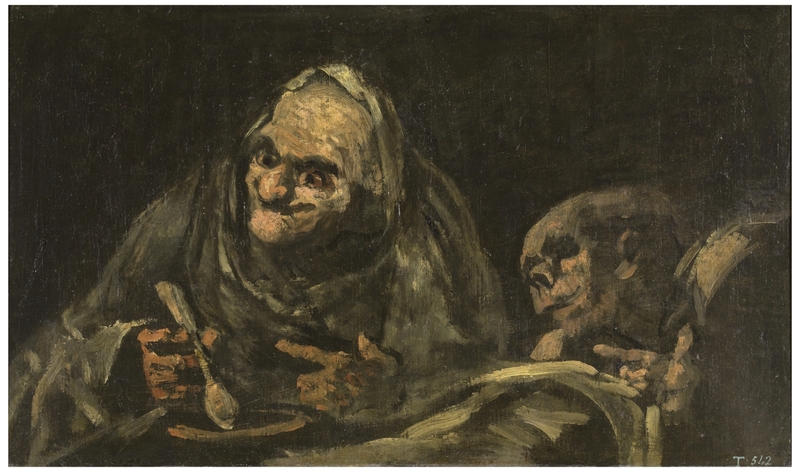Black Paintings
In 1819 Goya purchased a farmhouse in the countryside called La Quinta del sordo, close to Madrid. He fell extremely ill once again beginning his descent into madness while living at the villa. Declining health and political uneasiness, La Quinta del sordo is where Goya’s final visions of his world will be created, between 1820 and 1823, he painted the walls of two rooms in the villa with a series of 14 paintings, defined by their appearance and content, "The Black Paintings". These are some of Goya's most famous paintings due to the dark figurations striped of color and light , and mysterious meanings behind them, none of them were given names and were not found until after goya's death. The intimate and private atmosphere of the villa allowed goya to express himself with great liberty. The black paintings were originally mixed media oil based murals painted on the walls of his home (La Quinta del Sordo) by sections per floor levels of the house. The paintings were stripped off the wall and transferred to canvas, this was an impossible task and many details were destroyed or had to be restored.
Goya worked like a hermit, in complete solitude while painting this series, fully intending for no one to see them. Focusing on 3 paintings out of the 14 from this series, The Pilgrimage to San Isidro, two old men eating, and the witches sabbath, that each show the internal struggles Goya experienced in his personal life and political satire represented through his art.
Highlighting the passage of disillusionment was one of Goya’s paintings “The pilgrimage to san Isidor”. Originally in 1778 Goya painted "The Meadow of Saint Isidore", a colorful light painting meant to highlight this celebration, however 30 years later after the rise and fall of napoleon, the French occupation, the restoration of a dictator king, and the extension of the inquisition this painting was much darker and peculiar, the sky changing from sunshine, to dark and stormy and The once happy crowded now filled with madness, agony, and suffering. Located in the middle of the crowd is the reason for the subject's suffering and pain, Napoleon Bonaparte, who is one of the 20 political figures identified in these paintings. This painting is known as the inquisition addressing the dark and cruel presentation representing ignorance and superstition.
The second painting is “Two Old Men Eating” this is one of the smallest paintings and best preserved of the 14. It was located right above the doorway on the first floor where the entrance for the kitchen was located.
This painting has been interpreted in many ways, some think it's Goya predicting the end of his life, with the almost dead figure lying there and the older man smiling and looking to the left, maybe even looking at Goya as if he's next. Others see it as more political commentary on the gap between the haves and have nots, something that Goya had represented before in previous works. In this case the painting shows the figure on the left scarfing food down with a manic smile on his face. This figure was purposely looking away from the second figure who was practically decaying and dead. Goya represented the ignorance of the upper class in regards to the starving poor, turning their heads and ignoring the real issue at play.
Lastly is the witches sabbath, or the great he goat, this painting is one of the largest ones in the series and was modified by art historians by shrinking the painting and taking out black space on each end. Goya often left these black spaces to emphasize the deep and dark feelings the paintings emulate and ultimately the modification shifted the focal point of the painting.
Pictured is a goat, or Satan, on top of a small mound. The goat is giving instructions to those around him and is dressed like a priest, a statement made against the inquisition mocking them by representing the priest as the devil. The people in the crowd are thought to be witches, witchcraft images are prevalent due to the fear and superstition of the supernatural and how most people believed witches to be real. There is a woman in white who closely resembles a nun and is separated from others suggesting she is a new member of the coven who was just initiated. The painting is a critique of the church who accused enlightened thinkers of being devil worshipers and often condemned ideas of science as disruptive and harmful.




